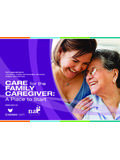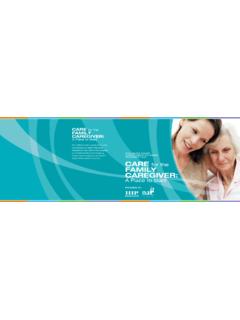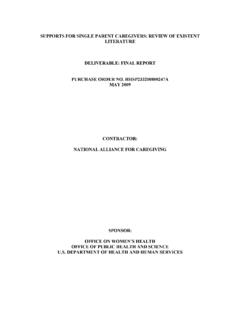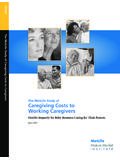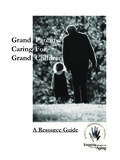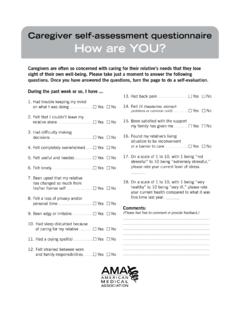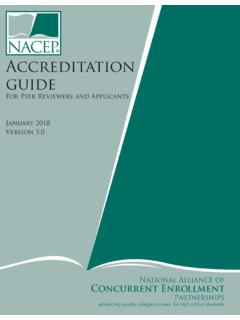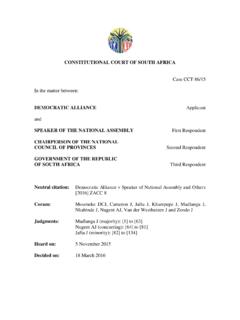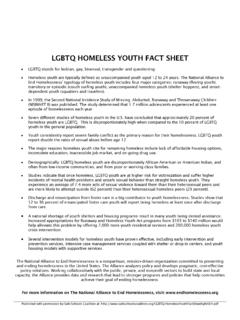Transcription of MULTIPLE SCLEROSIS CAREGIVERS
1 MULTIPLE SCLEROSIS . CAREGIVERS . March 2012 Conducted by The national alliance for Caregiving national MULTIPLE SCLEROSIS Society Southeastern Institute of Research, Inc. Supported by Sanofi US. n STUDY SPONSORS. The national alliance for Caregiving Sanofi US. Established in 1996, The national alliance for Sanofi US is a diversified global healthcare Caregiving is a non-profit coalition of national leader that discovers, develops, and distributes organizations focusing on issues of family care- therapeutic solutions to improve the lives of giving. alliance members include grassroots everyone. organizations, professional associations, service organizations, disease-specific organizations, a Sanofi US works to prevent and treat the dis- government agency, and corporations. eases that we know of today, as well as those we may face tomorrow.
2 With nearly 100,000 dedi- The alliance was created to conduct research, cated professionals in more than 100 countries, do policy analysis, develop national programs, Sanofi US is devoted to advancing healthcare increase public awareness of family caregiv- around the world. Sanofi US, with headquarters ing issues, work to strengthen state and local in Bridgewater, New Jersey, employs more than caregiving coalitions, and represent the US 11,400 professionals throughout the country. caregiving community internationally. Recog- nizing that family CAREGIVERS provide important In 2010, Sanofi US donated over $40 million societal and financial contributions toward dollars to non-profit 501(c)(3) organizations maintaining the well-being of those they care across the In addition, over $500 million for, the alliance 's mission is to be the objective dollars in pharmaceutical product was donated national resource on family caregiving with the to patients in the and in developing coun- goal of improving the quality of life for families tries through our Patient Assistance Pro- and care recipients.
3 Gram and product and disaster relief programs. The alliance gratefully acknowledges the support and insight of the national MULTIPLE SCLEROSIS Society in the development of this study. MS CAREGIVERS |3. n TABLE OF CONTENTS. Introduction 7. Methodology 8. Summary of Key Findings 9. Caregiver & Care Recipient Profiles 12. Respondent Profile 12. Care Recipient Profile 16. Detailed Findings 18. MULTIPLE SCLEROSIS Problematic Symptoms 18. Care Provided by Family CAREGIVERS 23. External Help 26. Number of CAREGIVERS 26. In-Home Paid Care 28. Impacts on Caregiver 30. Emotional Impacts 30. Impacts from Providing Care 31. Choice in Providing Care 34. Cognitive Impairment 40. Information Sources and Technology 42. Gender 47. Long-Term Care Facilities 49. Changing Symptoms of MS 55. Policy Implications of the Study 61. 4 | MS CAREGIVERS . n TABLE OF FIGURES.
4 Figure 1: Respondent Education. 12. Figure 2: Respondent Income. 13. Figure 3: Respondents' Employment. 14. Figure 4: Point at Which Respondent Began Providing Care. 15. Figure 5: Respondent Relationship to Care Recipient. 16. Figure 6: Care Recipients' Employment. 17. Figure 7: Types of MS. 18. Figure 8: Disease Steps. 20. Figure 9: Symptoms of MS. 21. Figure 10: Impact of Symptoms on Day-to-Day Life. 22. Figure 11: Hours Spent Providing Care Each Week. 23. Figure 12: Activities of Daily Living. 24. Figure 13: Instrumental Activities of Daily Living. 25. Figure 14: Disease Steps by Number of CAREGIVERS . 26. Figure 15: Location of Residence by Number of CAREGIVERS . 27. Figure 16: Disease Steps by Paid In-Home Care. 28. Figure 17: Location of Residence by Paid In-Home Care. 29. Figure 18: Caregiver Emotions Upon Care recipients' Diagnosis with MS.
5 30. Figure 19: Negative Impacts on MS CAREGIVERS . 31. Figure 20: Specific Caregiver Impacts. 32. Figure 21: Positive Impacts on MS CAREGIVERS . 33. Figure 22: Relationship with Care Recipient by Choice in Providing Care. 35. Figure 23: Caregiver Impacts by Choice in Providing Care. 36. Figure 24: Specific Impacts on Relationship with Care Recipient by Choice in Providing Care. 37. MS CAREGIVERS |5. n TABLE OF FIGURES. Figure 25: Specific Impacts on Relationship with Other Family Members by Choice in Providing Care. 38. Figure 26: Negative Impacts by Cognitive Impairment. 40. Figure 27: Help needed by cognitive impairment. 41. Figure 28: Usage of Internet and Support Systems. 43. Figure 29: Helpfulness of Information Sources. 44. Figure 30: Likelihood of using new technologies. 46. Figure 31: Shared Caregiver Responsibilities by Gender.
6 47. Figure 32: Information Sources Used by Gender. 48. Figure 33: Potential Results if Care Recipient's Condition Worsens. 49. Figure 34: Likelihood of Going to Long-Term Care Facility. 50. Figure 35: Likelihood of Going to a Long-Term Care Facility by Relationship to Care Recipient. 51. Figure 36: Likelihood of Going to a Long-Term Care Facility by Choice in Providing Care. 52. Figure 37: Trigger Points for Going to a Long-Term Care Facility. 53. Figure 38: Opportunities for Keeping Care Recipients in Their Homes Longer. 54. Figure 39: Stability of Symptoms. 55. Figure 40: Caregiver Views Toward Frequently Changing Symptoms. 56. Figure 41: Caregiver Impacts by Stability of Symptoms. 57. Figure 42: Helpfulness of Information Sources by Stability of Symptoms. 58. Figure 43: Opportunities for Keeping Care Recipient in Their Own Home by Stability of Symptoms.
7 59. Figure 44: Usage of Caregiving Technology Tools by Stability of Symptoms. 60. 6 | MS CAREGIVERS . n INTRODUCTION. M. ultiple SCLEROSIS (MS) is a chronic, eastern Institute of Research to conduct an unpredictable, often disabling disease in-depth study of family CAREGIVERS caring for that attacks the central nervous sys- loved ones with MS. Specific objectives of this tem. Symptoms can vary dramatically study include: from person to person and can include loss of balance, poor coordination, slurred speech, Collect demographic, psychographic and at- tremors, numbness, extreme fatigue, problems titudinal data about people engaged in caring with memory and concentration, paralysis, at home for someone with MS. blindness, and more. Depending on the spe- Investigate how the changing symptoms relat- cific person with MS, these problems may be ing to cognition, mood changes, and inconti- permanent or may come and go.
8 It is estimated nence impact caregiving and CAREGIVERS . that approximately 400,000 Americans have MS. The vast majority of people with MS live a Explore the intersection of technology and normal lifespan, but the unpredictability of the care for someone with MS. disease can present many challenges, including Examine the triggering events for moving into the possibility of facing increasing a long-term care facility and better under- The unpredictability also presents many chal- stand what resources or tools could help fam- lenges for those providing care to a loved one ily CAREGIVERS keep their care recipient with with MS. In order to better understand the MS in the home longer. needs of family CAREGIVERS providing care for Understand the role of men as the primary someone with MS, the national alliance for caregiver to MS care recipients.
9 Caregiving, with funding from Sanofi US, part- nered with the Boomer Project of the South- 1. national MS Society. MULTIPLE SCLEROSIS : Just the Facts. national MS Society, 2011. MS CAREGIVERS |7. n METHODOLOGY. T. his report presents the findings of an online respondents completed the survey between July- quantitative survey of 421 individuals who October 2011. CAREGIVERS were alerted of the sur- provide care to a friend or family member vey through the following sources: national MS. suffering from MULTIPLE SCLEROSIS (MS). Society Caregiver webpage, national MS Society self-help groups, national MS Society Relation- All respondents were members of a national ship Matters program, national MS Society's online panel hosted by Research Now. Research Facebook page, national MS Caregiver website, Now is the world's leading marketing research Caregivingly Yours blog, personal blogs of MS.
10 Panel provider and data collection services CAREGIVERS . Specific numbers presented in this company. In order to qualify for the survey, re- report reflect findings from the national Panel spondents must be currently caring for a friend Study only. The data from the MS Community or family member with MS and must help Survey closely resemble that of the national their care recipient with at least one Activity of Panel with a few minor exceptions, including: Daily Living (ADL) or Instrumental Activity of Daily Living (IADL) other than just managing CAREGIVERS in the MS Community Survey finances. Anyone who reported they provide report providing significantly more care each paid professional care to someone with MS was week than CAREGIVERS in the national Panel disqualified from the survey. Survey (40 hours vs. 24 hours respectively).



